The story of Fortuné and Léopoldine Mollot and their ancestors is a most interesting narrative for all of us to cherish. We have a rich ancestry that fortunately has been well documented. It is truly amazing that in looking at our family tree, you and I can reflect and ponder back some thirteen generations to our direct ancestor Georges Mollot, a wheelwright, born in 1613 in Trouans, back eight generations to Louis Mollot, a silk merchant, born in 1791 in Châlons en Champagne, and back four generations to Fortuné Mollot, an artist born in 1845 in Lyon and so the story continues! Whoever reads this narrative can also relive the family’s past.
It is hoped that this summary, A Journey into the Mollot and Benoit Family Tree, provides information necessary to the understanding, appreciation and knowledge of our family heritage. It is hoped that family members will share this information and pass it on to future generations.
A sequel to this document is necessary to outline the lives of the next generation; that of Gabrielle (21), Ernest (22), Marcel (23), Marie Louise (Lily) (24) and Thérèse (25)!
I hope you have enjoyed this Mollot family tree journey!
Sincerely, VIC MOLLOT
APPENDIX OF DOCUMENTS AND CERTIFICATES
The Memoires of Fortuné Mollot, dated July 18, 1912
Family research of Pascal Pierre, French genealogist, Trouans, France
Various items from the family archives:
· Civil death certificate - Louis Fortuné Mollot - June 10, 1871 - Blandin
· Civil marriage registration & contract - Louis Fortuné Mollot and Thérèse AnnequinDec.8,1844- Châbons
· Civil registration - Birth of Fortuné Louis Mollot - Nov.4, 1845 - Lyon
· Civil registration - Birth of Louis Fortuné Mollot - Feb. 15, 1791 - Châlons sur Marne
· Holy Cross Cemetery, Culver City, California - Death records of Léopoldine Mollot née Benoit - April 20, 1944
· Last Will and Testament Ernestine Benoit née Croze - March 21, 1887 - Die
· Last Will and Testament of Dr. Alexandre Benoit – Dec. 20, 1892 - Die
· Last Will and Testament of Francoise Collet née Mollot----add date
· Last Will and Testament of Louis Fortuné Mollot - Dec. 12, 1869
· Letter-Comte de Paris to Fortuné Louis Mollot, mayor of Blandin - July 4, 1888
· Reminiscences of my student life in Paris by Gabrielle Mollot, April 25, 1925
· St. Boniface Parish Archival records - death records of Fortuné Louis Mollot -April 22, 1924
· St. Boniface Parish Archival records - death records of Gabrielle Mollot – Sept. 2, 1931
· Terms of the sale of “le Martouret” - July 7, 1896 - Die
Archives Departementales de L’Aube, Troyes, France (for research of ancestors in Trouans, Dosnon, and Lhuitre)
· Claude Mollot - church death record - May 26, 1727 - Trouans-Microfilm #5MI476P Années 1707 - 1754
· Georges Mollot - church birth/baptism record - April 18, 1706 –Trouans - Microfilm # 5MI476P Années 1570 -1706
· Georges Mollot and Sire Beaurieux-church marriage certificate - Trouans - Nov. 26, 1742
· Louis Mollot and Jeanne Milliat - church marriage certificate - Nov.23, 1701 - Trouans
· Louis Mollot-church death record - Dec. 21, 1747 – Trouans - Microfilm #5MI476P Années 1707 - 1754 or LDS* Microfilm #1982967
· Marie Angelique Mollot - church birth/baptism record - Mar. 20, 1758 - Dosnon - Microfilm # 5 MI 101P or LDS microfilm # 1897626
· Pierre Mollot - church birth/baptism record - May 23, 1747 – Dosnon - Microfilm # 5MI 101P or LDS microfilm # 1897626
Archives Departementales de la Marne, Châlons en Champagne, France (for research of ancestors in Châlons sur Marne)
· Capitaine Jean Marie Fortuné Collet-civil death certificate - Oct. 7, 1850 -Châlons-Document # 2E119/413 or LDS microfilm # 2330127
· Françoise Jeanne Collet née Mollot - Sept. 29, 1869-civil death certificate - Châlons - LDS microfilm # 2330087 Années 1865 -1875
· Françoise Jeanne Mollot - church birth/baptism record - June 23, 1788 - Châlons - LDS microfilm # 2329070
· Jean Toussaint Freminet - church birth/baptism record - Oct.31, 1722 - Châlons
· Jean Toussaint Freminet - church death certificate-Aug. 31, 1789 - Châlons-Document # 2E119 - Années 1781 - 1792 and LDS microfilm # 2329070. Also found on LDS microfilm #2361445 in index table.
· Jean Toussaint Freminet and Françoise Collard - church marriage certificate-Feb. 18, 1754 –St. Eloi Church- Châlons - LDS microfilm # 2361444 - index table 1753-1772
· Louis Fortuné Mollot - church birth/baptism record - Feb. 15, 1791-Châlons - Document # 2E119-Années 1781-1792
· Marie Joseph Françoise Freminet - church birth registration - Feb. 25, 1756 - Châlons - St. Eloi Parish index tables - Années 1753 -1772
· Marie Joseph Françoise Freminet-church birth certificate-Feb. 25, 1756-St. Eloi Church-Chalons
· Marie Joseph Françoise Mollot née Freminet - civil death certificate - Jan. 15, 1846-Châlons - Document # 2E119/413 or LDS microfilm # 2330127
· Pierre Mollot - civil death record - Aug. 5, 1810 – Châlons - LDS microfilm # 2330125
· Pierre Mollot and Marie Joseph Françoise Freminet - church marriage certificate - May 7, 1787 - Châlons - Document # 2E119 - Années 1781-1792. Also found on LDS microfilm # 2361445 in index table.
Archives Départementales de L’Isère, Grenoble, France (for research of ancestors in Blandin, Châbons and Grand Lemps)
· Gabriel Henri Marcel Mollot - civil birth certificate registration - Oct. 22, 1880-Blandin -Microfilm # 5E-47/3 -12 and LDS microfilm # 2101855
· Louis Fortuné Mollot - civil death certificate-June 10, 1871 – Blandin
· Louis Fortuné Mollot and Thérèse Annequin - civil marriage certificate - Dec. 8, 1844 - Châbons - Document # 5E66/4-14 or LDS microfilm # 2067224
· Marie Louise Eugénie Dieudonné Mollot - civil birth certificate registration - Feb. 27, 1891 - Blandin - Microfilm # 5E-47/3 - 12 or LDS microfilm # 2101855
· Thérèse Annequin - civil birth records - Dec. 31, 1806 – Châbons - LDS microfilm # 2067021
Archives Départementales de L’Ardêche, Privas, France (for research of ancestors in Privas and La Voulte)
· Agathe Ernestine Julie Croze - birth certificate - Feb. 25, 1823 - Privas -Document # 4 E 186 art - Année1823
· Eugénie Marie Appolinaire d’Azémar - civil birth certificate - Jan. 18,1803 - Privas-LDS microfilm # 0396393
· Jacques Hubert Croze - church birth record - June 20, 1789 - Privas - LDS microfilm # 0396390 - Années 1768 -1792
· Jacques Hubert Croze and Eugénie Marie Appolinaire d’Azémar - Civil record - 1st marriage publication - Married Aug. 2, 1819-Privas - LDS microfilm #0396398
· Léopold Michel Martial d’Azémar - civil birth certificate - May 5, 1804 - Privas - LDS microfilm # 0396393
Archives Départementales de la Drôme, Valence, France (for research of ancestors in Die)
· Agathe Ernestine Julie Benoit née Croze - civil death record - Mar. 22, 1887 - Die
· Archives Municipales de Lyon, Lyon, France
· Dr. Alexandre Gabriel Hubert Benoit - civil birth certificate - April 27, 1818-Die - LDS - microfilm # 371897. Also found on index table - LDS microfilm #0375060
· Fortuné Louis Mollot - Church baptism certificate - Nov. 4, 1845 - Lyon-Obtained from Eglise Notre Dame St. Vincent, Lyon, France
· Fortuné Louis Mollot - Civil birth registration - Index-Nov. 4, 1845 - Lyon, France - Registres paroissiaux et d’état civil document # 2E462 - page 174
· Fortuné Louis Mollot - Civil birth registration certificate - Nov. 4, 1845-Lyon, France - Registres paroissiaux et d’état civil - document # 2E416 - page 281
· Fortuné Louis Mollot and Marie Léopoldine Anais Benoit - civil marriage registration - Oct. 4, 1872 - Die - LDS microfilm # 2432109
· Jean Baptiste Benoit Algoud - Civil birth registration certificate - July 14, 1819 - Registres paroissiaux et d’état civil - document # 2E183 – page 3
· Jean Baptiste Benoit Algoud and Thérèse Pauline Mollot - Civil marriage registration certificate - Sept. 13,1852 - Lyon, France-Registres paroissiaux et d’état civil-document #2E854 - page 186
· Louis Jean Ernest Mollot - civil birth registration - Aug. 29, 1879 - Die- 1792 - 1892 Civic Tables # 2M18-R113 or LDS microfilm # 375060
· Marie Léopoldine Anais Benoit - civil birth record - July 8, 1852 – Die - LDS microfilm # 371906 - Années 1793-1852
· Thérèse Gabrielle Mollot - Civil birth registration - Index- Dec.4, 1875, Lyon, France - Registres paroissiaux et d’état civil-document # 2E570 - page 20
· Thérèse Gabrielle Mollot - Civil birth registration certificate - Dec.4, 1875 - Lyon, France - Registres paroissiaux et d’état civil - document # 2E570 - page 201
· Thérèse Mollot née Annequin - Civil death certificate - Dec. 4,1862 - Registres paroissiaux et d’état civil-document # 2E885 – page 258
· Thérèse Mulin (Annequin) Civil birth registration certificate – Sept. 20, 1832 - Registres paroissiaux et d’état civil-document # 2E265-page 129
· Thérèse Pauline Mollot - Civil Adoption Registration certificate - August 31,1852 - Lyon, France- Registres paroissiaux et d’état civil-document # 2E 458 – page 147
Other sources
· Archdiocese of Winnipeg Archival Records
· Archdiocese of St. Boniface Archival Records
· Archives Manitoba - Winnipeg, Manitoba
· Canada Census-of the years 1901, 1906, 1911, and 1916
· Canada Immigration - passenger list - S. S. Circassion - Allan Shipping Line - Aug. 25, 1892
· Canadian Genealogy Index - 1901
· Canadian passenger lists of 1906, 1907, 1926, 1927 1928, 1929, and 1930
· Collège Universitaire de St. Boniface - Enrolment records of 1892-1894
· Dictionnaire des artistes de langue française en Amérique du Nord par Bernard Mulaire, University of Laval, 1992
· Ecole Provencher School-Archival Records-Louis Riel School Division
· Fannystelle - Western People - May 25, 1989 by Constance Franzmann
· Fannystelle Church records
· Henderson’s City of Winnipeg Directory-for the years 1900 to 1945
· Henderson’s Manitoba & North West Territories Gazetteer and Directory - for the years - 1892 to 1935
· Henri D’Hellencourt - Journaliste Français du Manitoba (1895-1905) par Bernard Pénisson
· L’Histoire de Fannystelle par Noel Bernier, 1939
· La Famille D’Azémar à la Voulte sur Rhône by L’Abbé Auguste Roche
· La France Moderne printed by Lafitte Reprints - 1908
· Le Manitoba - Sept.14, 1892 issue-Mollot family arrival.
· Les Français dans L’Ouest Canadien par Donatien Frémont
· Manitoba Genealogical Society, Winnipeg, Manitoba
· Manitoba Land Titles - Land Title Certificate of the Fannystelle farm - Sept. 15, 1894
· Marriage contract of Angelique Mollot and Paul Bardon-Dosnon - Jan. 4, 1795-Obtained from Yolande Rosez
· Mollot, Fortuné -Death announcement - Manitoba Free Press-April 24, 1924 - page 4
· Mollot, Fortuné -Death announcement - Le Manitoba - April 30, 1924 - page 4
· Mollot, Gabrielle-Death announcement-La Liberté-Sept. 9,1931 - page 8
· Mollot, Gabrielle-Death announcement-Manitoba Free Press-Sept. 3.1931 - page 5, Sept. 4, 1931-page 3, and Sept. 5, 1931 - page 21 issues.
· Mollot, Marcel - Death announcement - La Liberté - Dec. 12,1934 - page 2
· Municipality of Grey Archival Records, Elm Creek, Manitoba
· New York passenger lists of 1911, 1921 and 1932
· Société Historique de Saint Boniface, St. Bonface, Manitoba
· St. Mary’s Church Archival records-Parishioners lists
· St. Mary’s School in the Archdiocese of Winnipeg-Archival school registers from the Sisters of the Holy Names - 1904 to 1939.
· The Museum of Die, France
· The Winnipeg Tribune - Sept. 3 &7, 1931 issues
· U. S. /Canada Border Crossing lists, 1918, 1920
· Web sites-Archives municipales de Lyon, France
· Western Canada Gazetter and Directory -1898 to 1907
· Winnipeg newspapers - The Winnipeg Free Press, The Winnipeg Tribune, La Liberté et le Patriote, Le Manitoba, The Morning Telegram, Libre Parole, Echo du Manitoba, and the Daily Nor’Wester.
· Numerous web-sites such as Ancestry.com, and shiplists.com,
* LDS denotes Latter Day Saints. The Church of Latter Day Saints, better known as the Mormon Church, has state of the art Family Research Centres throughout the world for anyone to access free of charge. In the last 80 or so years, they have microfilmed millions of archival church and civil records from the 4 corners of the earth.
A number of the above records/certificates were obtained from this source.
Attachments: Mollot Family Tree – 2nd edition-May, 2010
In the next edition
The next generation (The children of Fortuné and Léopoldine)
Version française à suivre.


 Yves and Martine Marquié with Marc Mollot, August 2008, 20 yrs after Marc's student exchange.
Yves and Martine Marquié with Marc Mollot, August 2008, 20 yrs after Marc's student exchange.
 L. to R. Yolande Rosez, Pascal, Vic Mollot and René Rosez.
L. to R. Yolande Rosez, Pascal, Vic Mollot and René Rosez.
 Aug 2008 Tour de France at Eglise St. Georges, Trouans, France
Aug 2008 Tour de France at Eglise St. Georges, Trouans, France

 Eglise St. Georges built in the thirteenth century in Trouan le Grand
Eglise St. Georges built in the thirteenth century in Trouan le Grand

 Françoise Marie Joseph Mollot - née Freminet circa 1840.
Françoise Marie Joseph Mollot - née Freminet circa 1840.
 View of #4 Rue Basse. Originally, the Freminet caves were behind this structure.
View of #4 Rue Basse. Originally, the Freminet caves were behind this structure.
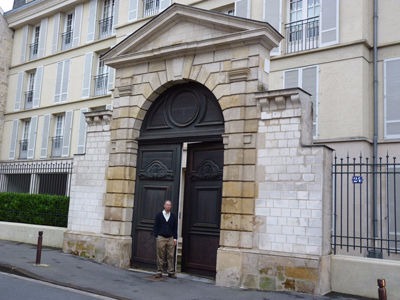 View of #24 Rue Pasteur.
View of #24 Rue Pasteur.
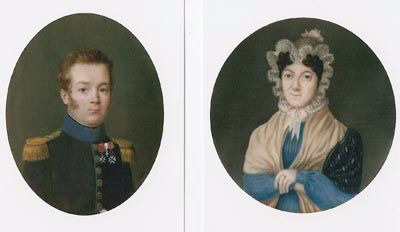 Capitaine Fortuné Collet and spouse Françoise Collet née Mollot
Capitaine Fortuné Collet and spouse Françoise Collet née Mollot
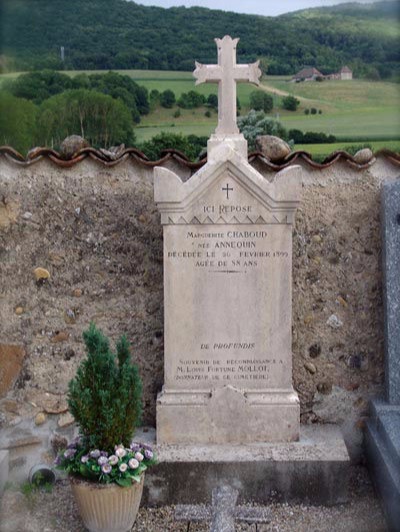 Monument in the cemetery in Blandin, France
Monument in the cemetery in Blandin, France
 Place Sathonay, 2008
Place Sathonay, 2008
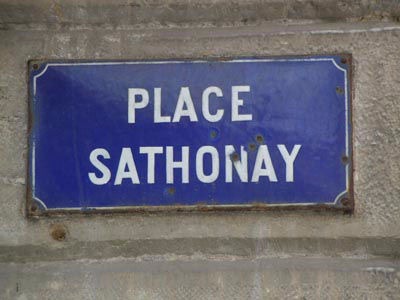
 In 1871, Fortuné age 26, Léopoldine age 19.
In 1871, Fortuné age 26, Léopoldine age 19.
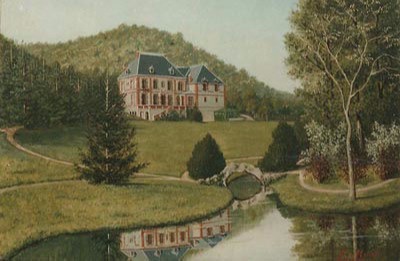 Painting: Chateau Blandin by Fortuné Mollot circa 1880
Painting: Chateau Blandin by Fortuné Mollot circa 1880
 The dining room. Note the restored chandelier andFortuné’s paintings which adorn the walls.
The dining room. Note the restored chandelier andFortuné’s paintings which adorn the walls.
 The living room.
Note the original ceiling.
The living room.
Note the original ceiling.


 The duck pond in the front yard of Château de Molinière
The duck pond in the front yard of Château de Molinière
 Arlette and Michel Auclerc, August 2008
Arlette and Michel Auclerc, August 2008
 2010 – The Canadian maple tree, planted in 2008 to commemorate the Tour de France, thrives in the front yard at Château de Molinière. L. to R. Lucille Mollot, Arlette Auclerc and Vic Mollot
2010 – The Canadian maple tree, planted in 2008 to commemorate the Tour de France, thrives in the front yard at Château de Molinière. L. to R. Lucille Mollot, Arlette Auclerc and Vic Mollot
 1816 – GENERAL BARON JEAN-JACQUES D’AZEMAR (16)
1816 – GENERAL BARON JEAN-JACQUES D’AZEMAR (16)
 BARON GENERAL LEOPOLD MICHEL MARTIAL d’AZEMAR- 1804-1888 (18)
BARON GENERAL LEOPOLD MICHEL MARTIAL d’AZEMAR- 1804-1888 (18)
 Die - France
Die - France


 General Baron Adolphe Henry Gaston d'Azemar
General Baron Adolphe Henry Gaston d'Azemar
 Fortuné Louis Mollot (approx. age 40) and Léopoldine Mollot, née Benoit (approx. age 33) circa 1885
Fortuné Louis Mollot (approx. age 40) and Léopoldine Mollot, née Benoit (approx. age 33) circa 1885
 Fortuné Mollot family crest and his logo as a wine producer
Fortuné Mollot family crest and his logo as a wine producer

 Self portrait of Fortuné Mollot in his
studio in Blandin. Painting of Léopoldine Mollot by Fortuné.
Self portrait of Fortuné Mollot in his
studio in Blandin. Painting of Léopoldine Mollot by Fortuné.
 Painting – ‘Reproches: Le Bavard et Le Moniteur’ circa 1887
Painting – ‘Reproches: Le Bavard et Le Moniteur’ circa 1887

 First Mollot family home in Fannystelle. The home was originally built in 1893.
First Mollot family home in Fannystelle. The home was originally built in 1893.
 Sacred Heart Church, Fannystelle, 1894.
Sacred Heart Church, Fannystelle, 1894.
 Signatures from Mollot Birth Certificates
Signatures from Mollot Birth Certificates
